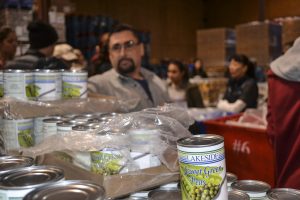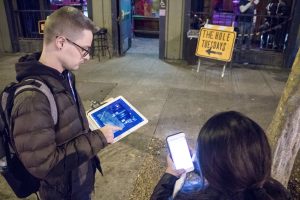The Connection Between Poverty, Inequality and Firearm Violence UCLA Luskin’s Mark Kaplan explains how circumstances in U.S. urban centers go hand in hand with gun violence
By Stan Paul
A fatal gunshot wound. This is a slide that Mark Kaplan, professor of Social Welfare at the UCLA Luskin School of Public Affairs, shows early in his presentation on gun violence.
As he recites annual gun death statistics in the United States, the vivid and unsettling scene serves as a backdrop.
“This might have been a suicide, this might have been a homicide; we’re not exactly sure. All I can tell you is that it was a fatal gunshot wound,” said Kaplan who spoke on “Poverty, Inequality and Firearm Violence,” Jan. 26, 2017 at the Luskin School as part of the Public Child Welfare Seminar series.
“The reason for putting this up is because quite often the discussion about guns is sanitized.” Kaplan explained, “We often treat the issue of gun violence as an abstraction but when you talk to people who are working in emergency departments, when you talk to coroners and medical centers, this is what people tell you. This is the net effect of guns.”
Across the nation, that net effect amounts to more than 33,000 similar scenes recorded each year on average, and more than 36,000 for 2015, Kaplan reported as the latest available data. What stands out for Kaplan is that two-thirds are suicides, his area of research. Kaplan, who holds adjunct appointments in psychiatry at the Oregon Health & Science University and in epidemiology and community medicine at the University of Ottawa, focuses on using population-wide data to understand suicide risk factors and firearm violence among vulnerable populations.
“So, the problem of gun violence in this country is primarily a suicide problem, less so a homicide problem,” said Kaplan to the audience, which included future social workers who are students in the master of social welfare (MSW) program. While recognizing the spike in gun deaths in cities such as Chicago – more than 50 in January in that city alone — Kaplan said that over the past 10-15 years there has been an overall national decline in the rate of gun deaths.
Kaplan said gun ownership in the U.S. is at more than 300 million and growing, and the death rate is only part of the story. He pointed out that for all of the recorded deaths by guns, there were more than 81,000 people – more than 200 per day – injured nationwide by guns in 2014.
“There are a lot of individuals who are shot, who survive, who wind up in emergency departments, are hospitalized and often disabled for life.”
A relationship exists between the high rate of guns and gun ownership and the number of homicides, suicides and injuries. Kaplan said that work is needed “on the ground” in America’s cities, such as limiting access to guns that would “go a long way to reducing some of the fatalities that we’re experiencing both in the homicide and suicide.”
He pointed to the work of one of his doctoral students that showed almost 90 percent of suicides involved guns in some parts of the country. California is an exception, according to Kaplan, who credited the state’s stringent gun control measures.
“California is an outlier. There aren’t many states like us,” he noted, suggesting that California could serve as a role model for the rest of the country. Unfortunately, two-thirds of states fall into the quadrant with both high rates of gun violence and lax restrictions on gun ownership, he said. “We are a gun-toting, gun-culture nation, and that’s going to make things a little bit challenging.”
The U.S. stands out among industrialized nations, Kaplan said. Gun homicides in the U.S. are 25 times higher than the average of other high-income countries. Factors such as poverty and inequality are contributing factors, he said.
“You all hear about poverty, but inequality is another measure of economic well-being. And there is a strong correlation between homicide per million and income inequality,” said Kaplan, pointing out that countries that are most equal have the lowest rates of gun-related homicides.
In terms of race and ethnicity, Kaplan said that 77 percent of white gun deaths in the U.S. are suicides, while less than 1 in 5 (19 percent) is a homicide. The figures are nearly opposite for African Americans, for which only 14 percent are suicides.
African American males in the 20-29 age group have the highest risk (89 per 100,000) in terms of the firearm homicide rate, a figure that is comparable with Honduras (90.4 murders per 100,000 people).
“In many ways we look like what some developing or Third World countries are experiencing,” Kaplan said.
Citing recent scholarship published by the Brookings Institution, he said that people who witness gun violence are also at increased risk for a variety mental health issues that can manifest as post traumatic stress disorder (PTSD), depression, poor academic performance, substance abuse, risky sexual behavior, delinquency and violent behavior – a “constellation of interconnected pathologies.”
Cities such as Los Angeles and New York have been stereotyped as “dangerous big cities,” Kaplan said, but both have benefitted from gun control measures. “Look how well we do in Los Angeles. New York is another place where the homicide rate has declined quite dramatically in the past 10-15, maybe 20, years.”
In contrast, Philadelphia today still has a high homicide rate, he said. And Texas, which has some of the least restrictive gun law on the books (with both Dallas and Houston appearing close to the bottom), has among the highest rates of gun deaths in the United States.

UCLA Luskin’s Mark Kaplan talks about a spike in gun violence in Chicago, a topic that has been much discussed by President Donald Trump and others. Photo by Stan Paul
Kaplan, who was born in Chicago, spoke about that city’s spike in murders in the past few years – nearly 300 shootings this January. One of Kaplan’s slides showed a recent tweet by President Trump about gun homicides in Chicago.
“We don’t know what [Trump] is going to do, but he is reacting to something legitimate” that is not occurring randomly, Kaplan said in reference to the accuracy of the numbers.
“You can approach this problem as a criminal justice problem … or approach it as a public health or social welfare or social justice problem, and that’s was missing in the discussion,” Kaplan said. Social inequality and income inequality are to some extent fueling the gun violence epidemic in Chicago, he noted.
Over the long term, however, little has really changed in Chicago, which has concentrated areas of poverty and racial segregation. Some areas are 90 percent African American. “Neighborhoods still look the same way as they did 10, 15, 20, maybe even 30, years ago. Chicago is a very divided city socio-economically,” Kaplan said.
The addition of guns increases violence. “The more guns, the more lethal the assault. When guns are absent, people are more likely to survive an assault,” said Kaplan. “If we could just tamp down the levels of gun ownership, that might – might – be the first step in trying to reduce the rate of gun violence.”
Compared to other leading causes of death in the U.S., the national investment in trying to understand and prevent gun deaths “pales by comparison” to what is spent on other causes of death and other major health problems, he said. A prohibition in the United States related to research on firearms doesn’t help.
“There is so much we need to know,” Kaplan said. “That’s what depresses me and keep me up at night.”




























